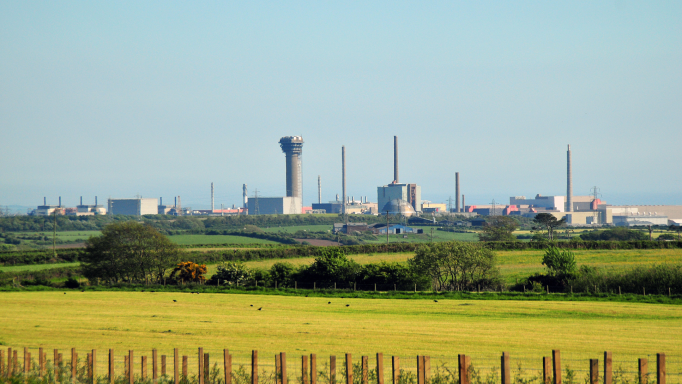
The UK Nuclear Decommissioning Projects You Need To Know About
01 May, 20198:15The United Kingdom has a long legacy as a pioneer of civil nuclear power. From the 1950s onw...

The United Kingdom has a long legacy as a pioneer of civil nuclear power. From the 1950s onwards, the British government commissioned and built a series of world-leading nuclear power stations. Now, these stations are in varying stages of being decommissioned which is leading to economic growth and job creation.
To manage the UK’s portfolio of facilities to be decommissioned the Nuclear Decommissioning Authority (NDA) was established in 2005. The NDA currently manages 17 sites across the UK at different stages of decommissioning- the most high-profile of which is Sellafield in Cumbria.
To give you an idea of the scale of the UK’s decommissioning activity, planned expenditure for the 2016-17 financial year was an enormous £3.2 billion (of which £3 billion was allocated for onsite expenditure, and £200 million for non-site expenditure such as skills development, socio-economic, research and development costs and NDA operating costs).
Now let’s take a closer look at the projects themselves…
Sellafield
Built and operated since the 1940s Sellafield was the world’s first commercial nuclear power station to generate electricity on an industrial scale; specifically, this was the Calder Hall facility which operated for 47 years, providing electricity to more than 200,000 homes before closing in 2003. Today, Sellafield represents one of the most challenging decommissioning challenges in the world, with the site home to more than 1,000 facilities.
Decommissioning activities that currently take place at Sellafield include reprocessing, radioactive waste management and storage. Since reprocessing began, more than 8,500 tonnes of fuel have been reprocessed through the thermal oxide reprocessing plant (Thorp) enabling 1,600 tonnes of recovered Uranium to be used again.
Sellafield is also home to another first; in 2011-12 the Windscale AGR (Advanced Gas-cooled Reactor) became the first UK nuclear powered reactor to be decommissioned.
The Magnox sites
Magnox was a UK designed reactor which operated for 50 years at various sites across the UK. At present there are 12 Magnox sites at various stages of being decommissioned:
Berkeley
Constructed during the early 1960s, with electricity generation commencing in 1962 the Berkeley site sits on the eastern bank of the River Severn in Gloustershire and came to the end of its operational life in 1989 having generated 43 TWh of electricity during its 27 years of operation. Since then Berkeley has undergone decommissioning activity, following the entry of the two reactors into safestore in 2010.
Bradwell
Located near to the Essex coastline, Bradwell began producing electricity in 1962, ceasing in 2002 having generated 60 TWh of electricity during this period. Covering a site of over 30 hectares Bradwell is currently following an accelerated decommissioning programme and is likely to be the first reactor site in the UK to enter C&M (Care & Maintenance).
Chapelcross
Scotland’s first commercial nuclear station, Chapelcross, was built on the site of an old airfield covering a total area of 92 hectares. Construction of the site began in 1955 which power generation beginning in 1959. Following 45 years of generating 60 TWh of electricity (station lifetime output), Chapelcross ceased operations in 2004. According to the NDA Chapelcross has recently completed defueling ahead of schedule and is progressing decommissioning for entry into interim C&M (Care & Maintenance).
Dungeness A
Occupying 22.8 hectares on the Kent coast, Dungeness A sits in the middle of a SSSI (Site of special scientific interest) and was connected to the National Grid in 1965. In the subsequent 41 years of operation Dungeness A generated 115 TWh of electricity. From the end of the power station’s operations in 2006, preparations were made for decommissioning. Defueling was completed in June 2012, and the demolition of the turbine hall was completed in June 2015. Dungeness A is expected to enter into the C&M (Care & Maintenance) stage in 2027.
Harwell
Harwell differs from the other sites on this list, as it was not used for commercial electricity generation. Instead the site was the home of Britain’s Atomic Energy Research Establishment from 1946 onwards. Located in rural Oxfordshire on the site of a former RAF (Royal Air Force) base, Harwell is essentially the birthplace of the UK nuclear industry. Harwell featured the most advanced radiochemistry laboratories in the world and allowed the safe handling of a wide range of radioactive materials. Of the site’s 14 experimental reactors, three remain today to be decommissioned. Harwell is currently entering into the decommissioning and restoration phase.
Hinkley Point A
In 2000 Hinkley Point A stopped generating electricity following 35 years of operation, having generated 130 TWh. The station’s two Magnox reactors supplied steam to three English Electric 93.5 MWe turbine generator sets which were, across both reactors, intended to produce 500 MWe net, however after de-rating of the reactor power output due to corrosion concerns, both reactors combined produced 470 MWe net. Located on a 19.4-hectare site on the Somerset coast, Hinkley Point A is a twin reactor site which is being decommissioned, currently in the C&M (Care & Maintenance) Preparations phase.
Hunterston A
30 miles south west of Glasgow, located on a promontory of the Ayrshire coast, you’ll find Hunterston A- a twin reactor site which, at the time of opening in 1969, was the largest operation of its kind anywhere in the world. The Hunterston A reactor design differs from the other Magnox sites listed here in that each reactor was raised up to a height of over 10 metres to enable refuelling to take place from underneath- meaning that gravity could assist the process of used fuel removal, negating the need to insert lifting machinery into the active core for on-load refuelling. Preparations for decommissioning began following the plant’s closure in 1989 after it had generated 73 TWh of electricity during its lifetime.
Oldbury
Spread across 39 hectares, Oldbury is 15 miles north of Bristol on the south bank of the River Severn in South Gloucestershire. Oldbury featured some unique design features- it was the first nuclear power station in the UK to use prestressed concrete pressure vessels. Earlier Magnox reactors used steel pressure vessels which were more suited to smaller reactors. Commissioned in 1967 Oldbury was eventually closed in 2012 following 44 years of successful operation, generating 137 TWh of electricity during that time. Decommissioning activity at Oldbury is currently focused on hazard removal to ensure entry into a C&M (Care & Maintenance) state safely and efficiently.
Sizewell A
2006 saw the closure of Sizewell A, a twin-reactor site which had been producing electricity since 1966 (generating 110 TWh during that time). Situated on a 10-hectare site near Leiston in Suffolk, Sizewell A has now completed defueling with the final flask of spent fuel leaving the site in 2014. Currently Sizewell A is making preparations to enter the C&M (Care & Maintenance) stage.
Trawsfynydd
Trawsfynydd was the first inland civil Magnox nuclear station, drawing its cooling water from Llyn Trawsfynydd, an inland lake in Snowdonia National Park, North Wales. The site occupies 15.4 hectares and began service in 1965, closing in 1993 having generated 69 TWh of electricity over that time. Decommissioning of the site began in 1993 when the highly-radioactive spent fuel rods were removed from both Magnox reactors and sent by rail to Sellafield for processing. This process was completed in 1997. Since then Trawsfynydd has been marked for accelerated entry to C&M (Care & Maintenance) one of only two Magnox sites to do so (the other being Bradwell).
Winfrith
Like Harwell, Winfrith was used for the research and development of experimental reactors. You can find the Winfrith site in the heart of the Dorset countryside amidst a SSSI (Site of special scientific interest). Built on Hardy’s Heath in the 1950 Winfrith provided vital research into reactor design. Of the nine unique reactors that were built, only two remain: Dragon, a helium cooled reactor which was widely regarded as one of Europe’s most successful collaborations in applied science and an important multi-national technical collaboration in nuclear energy; and the Steam Generating Heavy Water Reactor, the only one of Winfrith’s reactors to supply power to the National Grid. The site officially opened in 1960 with the ZENITH (Zero Energy High Temperature) reactor, with the Steam Generating Heavy Water Reactor following in 1967. The last reactor at Winfrith was shut down in 1995, although decommissioning of the site will not finish until 2021.
Wylfa
The last of the Magnox sites to be built (it was commissioned in 1971), Wylfa is located on the north coast of Anglesey between Amlwch and Holyhead. Construction of the two 490 MW reactors began in 1963, and the plant operated successfully until December 2015 after having produced 232 TWh of electricity during its operational lifetime. Wylfa is now in the defueling stage, after which the site will progress into C&M (Care & Maintenance). It is expected that the entire site will be free of spent nuclear fuel by late 2018.
The future of Magnox decommissioning
It is estimated that the total cost of decommissioning the UK’s Magnox power plants will be in the region of £12.6 billion, with the length of time for the completion of decommissioning potentially as much as 100 years (although there is currently a debate as to whether a 25 or 100-year decommissioning strategy should be adopted. This debate hinges on whether a fully robotic core dismantling technique could be utilised- which would negate the need for human access to the reactor structure- thus making decommissioning quicker).
Already 9 of the Magnox stations have been defueled and 99% of the radioactive hazard has been reduced from those sites. As part of this activity, some 3,300 tonnes of asbestos has been taken from the turbine hall, reactor buildings and heat exchangers.
Dounreay
Situated in the Highland area of Scotland west of the town of Thurso, the Dounreay site has been home to two nuclear establishments since the mid-1950s. The first of these establishments pursued the UK government policy of developing fast breeder reactor (FBR) technology. The second establishment was used for the development of nuclear propulsion plants for Royal Navy submarines. Both of these facilities are now in the process of being decommissioned and represent Scotland’s largest nuclear clean-up and demolition project. The experimental nature of these now-redundant facilities poses some complex decommissioning challenges that will continue to require real technological innovations to deal with.
Associated projects and sites
It takes a large support network to assist the UK’s nuclear decommissioning efforts. Below we take a look into some of the sites and projects that play an important role in the decommissioning of the UK’s defunct nuclear sites.
Springfields
Previously a Second World War munitions factory, Springfields was converted in 1946 to become a nuclear fuel production facility. The site is notable for being the first nuclear plant in the world to produce fuel for a commercial power station (Calder Hall). Whilst fuel production is Springfield’s main activity, it does also play a role in supporting the decommissioning and demolition of redundant plants and buildings across the UK. Manufacturing is set to continue until 2023, despite 87 buildings on the site having been fully demolished.
Capenhurst
Capenhurst in West Cheshire, England, is home to a uranium enrichment plant and associated facilities which ceased operation in 1982. Whilst most of the site has been decommissioned, uranic material (mostly depleted uranium and uranium hexafloride) is expected to be stored on the site until 2120. In 2012 ownership and operation of the NDA portion of the site was transferred to Urenco creating one nuclear licensed site.
Low Level Waste Repository (LLWR)
Since 1959, the Low Level Waste Repository near Drigg in west Cumbria has safely disposed of the UK’s low level waste. Containerised waste is grouted prior to disposal in engineered concrete vaults. In order to prolong the life of the repository, increasing amounts of low level waste are now being channelled through a variety of alternative waste management options. In 2015 the LLWR was granted a revised environmental permit to allow continued disposal of wastes at the site, potentially securing the LLWR’s future until approximately 2050.
Nuclear decommissioning as a source of growth and jobs
As you have read, the decommissioning of the UK’s nuclear legacy is set to take decades, if not even longer. As such, nuclear decommissioning is set to become, and remain, an important source of growth and jobs. The Nuclear Industry Association estimates that the British nuclear decommissioning industry ‘generates more than £1.7 billion of business per year for the UK (with over 21% of this spent with SMEs)’. Decommissioning is also an important source of jobs. More than 10,000 people alone are employed on the Sellafield site, with many more employed across the whole of the NDA estate that we’ve outlined above.
You’ve read about the UK’s nuclear decommissioning activity, now be a part of it with NES Fircroft
NES Fircroft’s dedicated team of nuclear industry recruiters help the UK’s leading nuclear decommissioning companies recruit both technical and non-technical talent. You can explore our current nuclear industry vacancies here.









